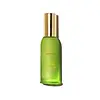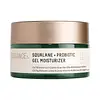What's inside
What's inside
 Key Ingredients
Key Ingredients

 Benefits
Benefits

 Concerns
Concerns

 Ingredients Side-by-side
Ingredients Side-by-side

Hordeum Vulgare Leaf Juice
EmollientMel
EmollientSimmondsia Chinensis Seed Oil
EmollientCitrullus Lanatus Seed Oil
EmollientGlycerin
HumectantGlyceryl Stearate Citrate
EmollientWater
Skin ConditioningPropanediol
SolventC13-14 Alkane
SolventAvena Sativa Kernel Oil
Skin ConditioningNigella Sativa Seed Oil
EmollientPyrus Malus Seed Oil
EmollientSantalum Spicatum Seed Oil
Skin ConditioningSqualane
EmollientBackhousia Citriodora Leaf Extract
AstringentSaccharide Isomerate
HumectantTasmannia Lanceolata Fruit/Leaf Extract
AntioxidantChlorella Vulgaris Extract
Skin ConditioningMagnolia Officinalis Bark Extract
AntimicrobialSalix Alba Bark Extract
AstringentSodium Hyaluronate
HumectantOlea Europaea Fruit Oil
MaskingArnica Montana Extract
Skin ConditioningBorago Officinalis Leaf Extract
Skin ConditioningCalendula Officinalis Flower Extract
MaskingMedicago Sativa Extract
TonicSpiraea Ulmaria Extract
AstringentSambucus Nigra Fruit Extract
AstringentSaccharomyces Ferment
Skin ConditioningPolyglyceryl-3 Stearate
EmulsifyingCaprylyl Glycol
EmollientHydrogenated Lecithin
EmulsifyingLysolecithin
EmulsifyingSclerotium Gum
Emulsion StabilisingGlyceryl Caprylate
EmollientXanthan Gum
EmulsifyingLauroyl Lysine
Skin ConditioningTocopherol
AntioxidantSodium Phytate
Pullulan
Phenethyl Alcohol
MaskingCitrus Limon Fruit Oil
AstringentOcimum Basilicum Oil
MaskingCitrus Aurantium Peel Oil
Citric Acid
BufferingSodium Citrate
BufferingLavandula Angustifolia Oil
MaskingAlcohol
AntimicrobialCymbopogon Flexuosus Oil
MaskingLactic Acid
BufferingFerula Galbaniflua Gum Extract
AntimicrobialLimonene
PerfumingLinalool
PerfumingCitral
PerfumingGeraniol
PerfumingFarnesol
PerfumingCitronellol
PerfumingHordeum Vulgare Leaf Juice, Mel, Simmondsia Chinensis Seed Oil, Citrullus Lanatus Seed Oil, Glycerin, Glyceryl Stearate Citrate, Water, Propanediol, C13-14 Alkane, Avena Sativa Kernel Oil, Nigella Sativa Seed Oil, Pyrus Malus Seed Oil, Santalum Spicatum Seed Oil, Squalane, Backhousia Citriodora Leaf Extract, Saccharide Isomerate, Tasmannia Lanceolata Fruit/Leaf Extract, Chlorella Vulgaris Extract, Magnolia Officinalis Bark Extract, Salix Alba Bark Extract, Sodium Hyaluronate, Olea Europaea Fruit Oil, Arnica Montana Extract, Borago Officinalis Leaf Extract, Calendula Officinalis Flower Extract, Medicago Sativa Extract, Spiraea Ulmaria Extract, Sambucus Nigra Fruit Extract, Saccharomyces Ferment, Polyglyceryl-3 Stearate, Caprylyl Glycol, Hydrogenated Lecithin, Lysolecithin, Sclerotium Gum, Glyceryl Caprylate, Xanthan Gum, Lauroyl Lysine, Tocopherol, Sodium Phytate, Pullulan, Phenethyl Alcohol, Citrus Limon Fruit Oil, Ocimum Basilicum Oil, Citrus Aurantium Peel Oil, Citric Acid, Sodium Citrate, Lavandula Angustifolia Oil, Alcohol, Cymbopogon Flexuosus Oil, Lactic Acid, Ferula Galbaniflua Gum Extract, Limonene, Linalool, Citral, Geraniol, Farnesol, Citronellol
Water
Skin ConditioningGlycerin
HumectantSqualane
EmollientLepidium Sativum Sprout Extract
Skin ConditioningSodium Acrylates Copolymer
Caprylic/Capric Triglyceride
MaskingBisabolol
MaskingPhospholipids
Skin ConditioningHansenula/Kloeckera/Lactobacillus/Lactococcus/Leuconostoc/Pediococcus/Saccharomyces/Fig/Lemon Ferment
Skin ConditioningSodium Hyaluronate
HumectantChondrus Crispus Extract
Skin ConditioningAllantoin
Skin ConditioningGlycine Soja Sterols
EmollientLinoleic Acid
CleansingCapryloyl Glycerin/Sebacic Acid Copolymer
Skin ConditioningDiheptyl Succinate
EmollientCellulose Gum
Emulsion StabilisingLecithin
EmollientSorbitan Oleate
EmulsifyingIsoeicosane
EmollientChitosan
Sodium Phytate
Caprylyl Glycol
EmollientPhenoxyethanol
Preservative1,2-Hexanediol
Skin ConditioningCitric Acid
BufferingWater, Glycerin, Squalane, Lepidium Sativum Sprout Extract, Sodium Acrylates Copolymer, Caprylic/Capric Triglyceride, Bisabolol, Phospholipids, Hansenula/Kloeckera/Lactobacillus/Lactococcus/Leuconostoc/Pediococcus/Saccharomyces/Fig/Lemon Ferment, Sodium Hyaluronate, Chondrus Crispus Extract, Allantoin, Glycine Soja Sterols, Linoleic Acid, Capryloyl Glycerin/Sebacic Acid Copolymer, Diheptyl Succinate, Cellulose Gum, Lecithin, Sorbitan Oleate, Isoeicosane, Chitosan, Sodium Phytate, Caprylyl Glycol, Phenoxyethanol, 1,2-Hexanediol, Citric Acid
 Reviews
Reviews

Ingredients Explained
These ingredients are found in both products.
Ingredients higher up in an ingredient list are typically present in a larger amount.
Caprylyl Glycol is a humectant and emollient, meaning it attracts and preserves moisture.
It is a common ingredient in many products, especially those designed to hydrate skin. The primary benefits are retaining moisture, skin softening, and promoting a healthy skin barrier.
Though Caprylyl Glycol is an alcohol derived from fatty acids, it is not the kind that can dry out skin.
This ingredient is also used as a preservative to extend the life of products. It has slight antimicrobial properties.
Learn more about Caprylyl GlycolCitric Acid is an alpha hydroxy acid (AHA) naturally found in citrus fruits like oranges, lemons, and limes.
Like other AHAs, citric acid can exfoliate skin by breaking down the bonds that hold dead skin cells together. This helps reveal smoother and brighter skin underneath.
However, this exfoliating effect only happens at high concentrations (20%) which can be hard to find in cosmetic products.
Due to this, citric acid is usually included in small amounts as a pH adjuster. This helps keep products slightly more acidic and compatible with skin's natural pH.
In skincare formulas, citric acid can:
While it can provide some skin benefits, research shows lactic acid and glycolic acid are generally more effective and less irritating exfoliants.
Most citric acid used in skincare today is made by fermenting sugars (usually from molasses). This synthetic version is identical to the natural citrus form but easier to stabilize and use in formulations.
Read more about some other popular AHA's here:
Learn more about Citric AcidGlycerin is already naturally found in your skin. It helps moisturize and protect your skin.
A study from 2016 found glycerin to be more effective as a humectant than AHAs and hyaluronic acid.
As a humectant, it helps the skin stay hydrated by pulling moisture to your skin. The low molecular weight of glycerin allows it to pull moisture into the deeper layers of your skin.
Hydrated skin improves your skin barrier; Your skin barrier helps protect against irritants and bacteria.
Glycerin has also been found to have antimicrobial and antiviral properties. Due to these properties, glycerin is often used in wound and burn treatments.
In cosmetics, glycerin is usually derived from plants such as soybean or palm. However, it can also be sourced from animals, such as tallow or animal fat.
This ingredient is organic, colorless, odorless, and non-toxic.
Glycerin is the name for this ingredient in American English. British English uses Glycerol/Glycerine.
Learn more about GlycerinSodium Hyaluronate is hyaluronic acid's salt form. It is commonly derived from the sodium salt of hyaluronic acid.
Like hyaluronic acid, it is great at holding water and acts as a humectant. This makes it a great skin hydrating ingredient.
Sodium Hyaluronate is naturally occurring in our bodies and is mostly found in eye fluid and joints.
These are some other common types of Hyaluronic Acid:
Learn more about Sodium HyaluronateSodium Phytate is the synthetic salt form of phytic acid. Phytic acid is an antioxidant and can be found in plant seeds.
Sodium Phytate is a chelating agent. Chelating agents help prevent metals from binding to water. This helps stabilize the ingredients and the product.
Squalane is an emollient that helps the skin hold onto moisture. It's an oily liquid that occurs naturally in certain types of fish and plant oils.
Because squalane boosts hydration in the skin, it also comes with plenty of benefits: it is an antioxidant and can help fight free radicals and skin damage. Squalane is also found to have a detoxifying effect when applied.
Squalane comes from squalene, which occurs naturally within the sebum of our skin. It is one of the oils our skin produces to keep itself hydrated. Squalane is the hydrogenated version of squalene and has a longer shelf life.
Research shows that squalane is non-irritating (even at 100% concentration).
In general, it's a fantastic ingredient. It does a great job at hydrating the skin, and it's suitable for those with sensitive skin.
The source of squalane may impact malassezia / fungal acne. This is because olive oil derived squalane can contain impurities such as fatty acids and plant waxes. Sugarcane derived squalane is recommended for anyone with malassezia concerns.
Is squalane vegan?
This depends on the source. Squalane can be derived from both plants and animals. Most squalane used in skincare comes from plants.
Please note: the source of squalane is only known if disclosed by the brand. We recommend reaching out to the brand if you have any questions about their squalane.
Read more about squalene with an "e".
Is squalane an oil?
Squalane is often called an oil, but it’s technically not; it’s a hydrocarbon, meaning it’s only made of carbon and hydrogen, unlike true oils which are triglycerides made of fatty acids and glycerol.
The term “oil-free” isn’t regulated, so companies can define it however they want. Some exclude all oils, while others just avoid mineral oil or comedogenic oils.
While some people avoid oils thinking they cause breakouts, the right kind of oil (or oil-like ingredient like squalane) can actually help balance and hydrate your skin. It’s worth testing out simple oils or squalane to see what works best for your skin.
Learn more about SqualaneWater. It's the most common cosmetic ingredient of all. You'll usually see it at the top of ingredient lists, meaning that it makes up the largest part of the product.
So why is it so popular? Water most often acts as a solvent - this means that it helps dissolve other ingredients into the formulation.
You'll also recognize water as that liquid we all need to stay alive. If you see this, drink a glass of water. Stay hydrated!
Learn more about Water